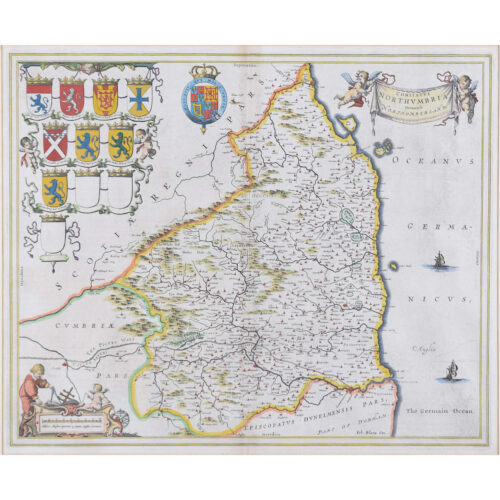-
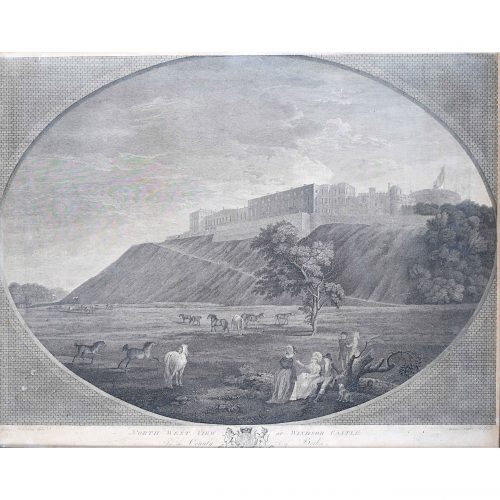
James Fittler (1758-1835) after George Robertson (1748-1788)
North West View of Windsor Castle in the County of Berks (1782)
47x58cm London: Published by John Boydell Fittler engraved two views of Windsor by Robertson. Trained at Royal Academy Schools, he was a skilled engraver and etcher and joined the mid-18th century trend for recording the landscape of the British Isles, producing and selling prints to tourists. A copy of this print is in the National Trust's collection at Anglesea Abbey, from Lord Fairhaven's extraordinary collection of views of Windsor Castle. -
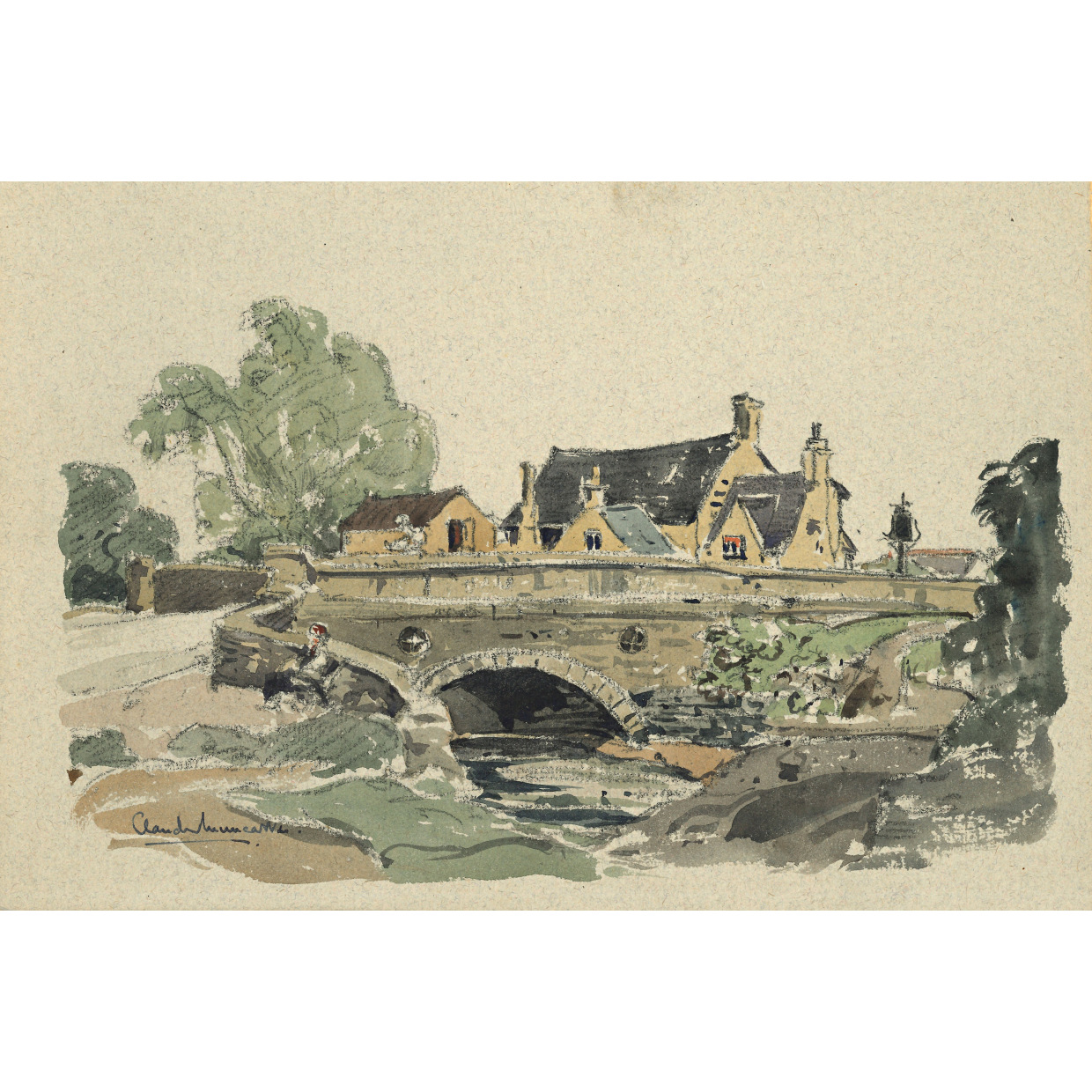
Claude Muncaster (1903-1974)
The Old George Inn South Cerney
Dated October 1952 to reverse Signed lower left and further signed to reverse Pencil and Watercolour 20x30cm Muncaster's watercolours capture the English countryside feel with great competence. Click here for biographical details and other works by the artist. If you are interested email info@manningfineart.co.uk or call us on 07929 749056. -
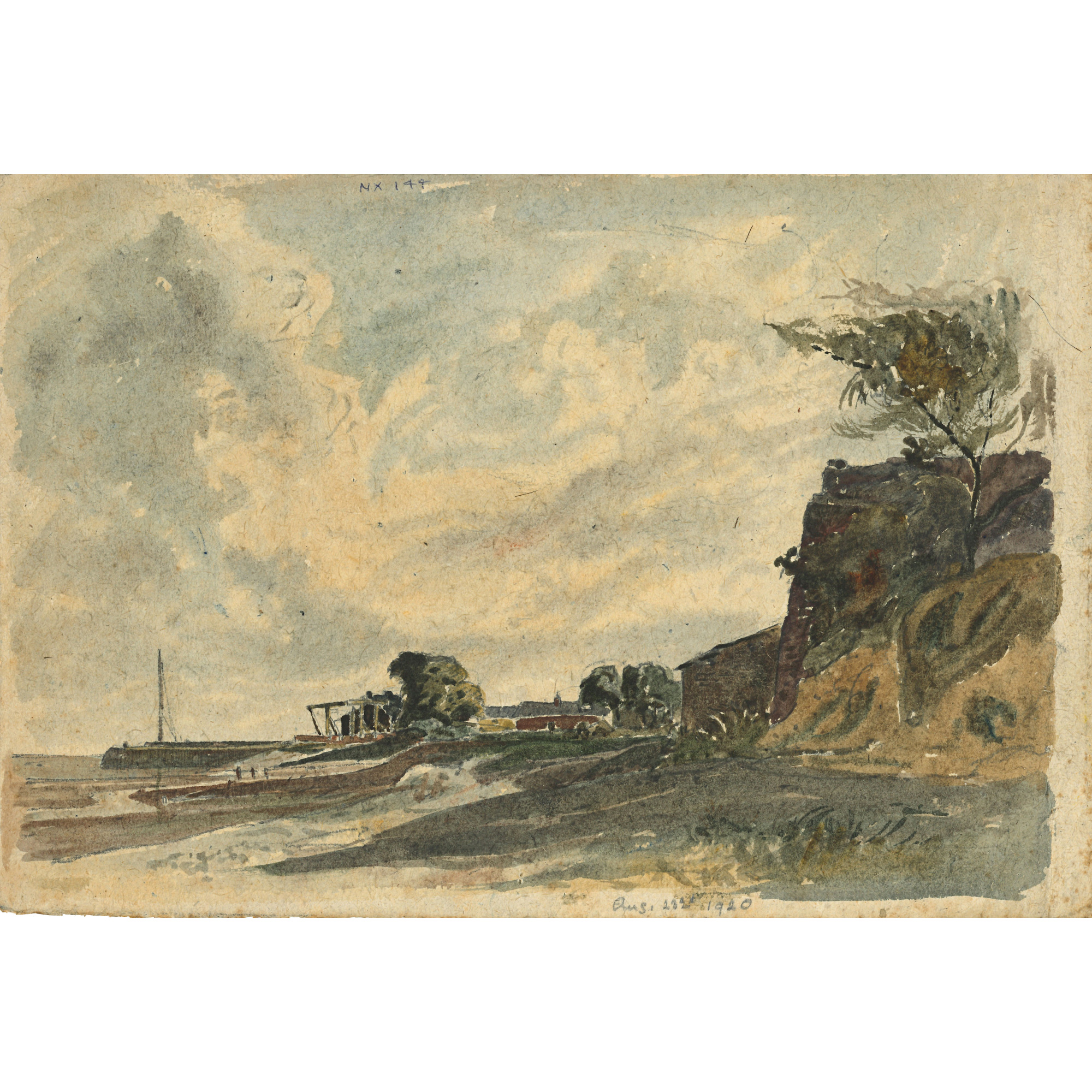
Claude Muncaster (1903-1974)
Canal Foot Ulverston Canal
Signed and titled to reverse Inscribed Aug. 23rd (?) 1920 Pen and watercolour 19x29cm Muncaster's watercolours capture the English countryside feel with great competence. Here he records the old swing bridge across the lock at the foot of the now-derelict Ulverston Canal. It was Britain's straightest canal, running two miles from Morecambe Bay to Ulverston but has long stood unused. Click here for biographical details and other works by the artist. If you are interested email info@manningfineart.co.uk or call us on 07929 749056. -
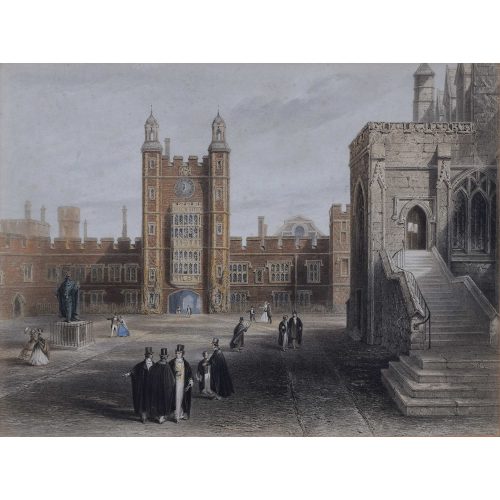
Anonymous (19th century) Eton College Courtyard
Lithograph 29 x 38 cm We have a pair of these rather fine 19th century lithographs: see the second one here. Mounted to board. -
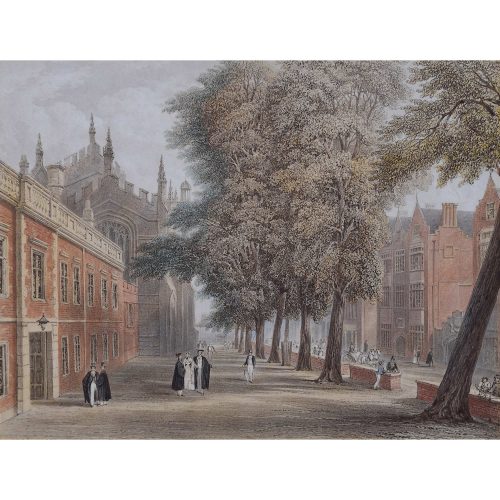
Anonymous (19th century) Eton College
Lithograph 29 x 38 cm We have a pair of these rather fine 19th century lithographs; view the other picture here. Condition: Mounted to board. -
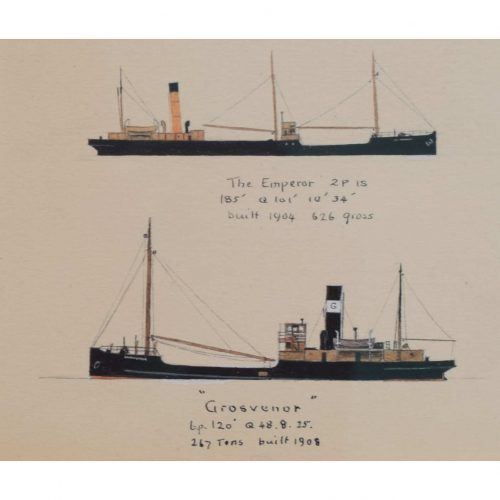
Laurence Dunn (1910 - 2006)
The Emperor and Grosvenor
Watercolour 8 x 9 cm Laurence Dunn was an artist known for his depictions of ships. He grew up in Devon, where he practised drawing passing ships, and went on to study at the Central School of Art. He then worked for shipbuilding firm John I. Thornycroft & Company Limited, where he contributed to the design of the Royal Yacht. During the Second World War, Dunn worked in naval intelligence. In the early 1960s, he created many line drawings of Atlantic ocean liners. The World Ship Society published the following obituary for Laurence Dunn in 2006: DUNN, Laurence. [December 15 2006 — Lloyds List] Many readers will be saddened by the death of well-known marine artist and writer Laurence Dunn in his 97th year. A man of encyclopaedic knowledge, he began his lifelong love of ships in Brixham, where he meticulously recorded passing traffic with the exquisitely accurate line drawings which later became something of a trademark. While studying at London’s Central School of Art his work was noticed by the Southern Railway, which commissioned profiles of its fleet, and this in turn led to work for Orient Line, where he also designed the well-known corn-coloured hull, and later Thorneycroft, where he helped with shaping draft plans for a new royal yacht. During the second world was he worked for naval intelligence at the Admiralty, where his technique did much to improve recognition standards, and greatly expanded his shipping clientele, becoming personally known to many chairmen. As well as the shipping press he worked for mainstream publications such as Everybody’s, Sphere and the upmarket comic Eagle. Through his many contacts he enjoyed going to sea in a great variety of ships from aircraft carriers to colliers. Laurence wrote several books, starting with ship recognition titles which introduced new standards of layout, but his best known work was probably Passenger Liners, which was widely taken up by the travel trade. His love of Greece, where he was an early publicist of island cruising, let to involvement in reshaping various passenger liners beginning with Greek Line’s OLYMPIA. In later life he designed several sets of shipping stamps for the Crown Agents, produced photographic volumes on Thames and Mediterranean shipping and still found time to enjoy the passing Thames traffic. Our sympathies go to his wife Jennifer, who provided succour to the many ship lovers who beat a path to the welcoming door of their Gravesend home. Condition: very good. If you'd like to know more, please email info@manningfineart.co.uk or call us on 07929 749056. -
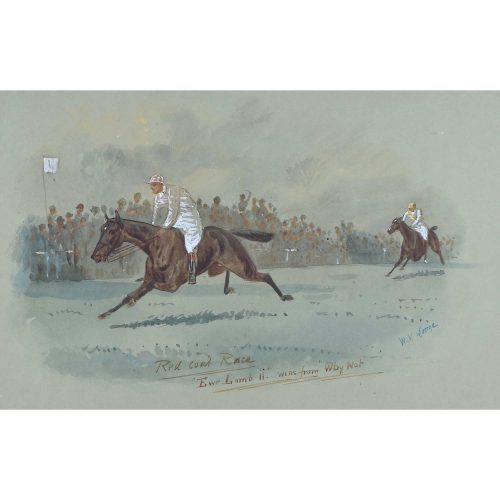
William Verner Longe (1857-1924)
Cottenham, December 1904
Watercolour 29 x 45 cm Signed and inscribed 'Red Coat Race, "Ewe Lamb ii" wins from "Why Not"'. A lively racing scene by William Verner Longe, and English artist noted for his scenes of racing, hunting, and other equestrian activities. He was educated at the Ipswich School of Arts and then the Royal Academy of Fine Arts in Antwerp. Condition: generally very good; original frame with antique glass. Some discolouration to margins. -
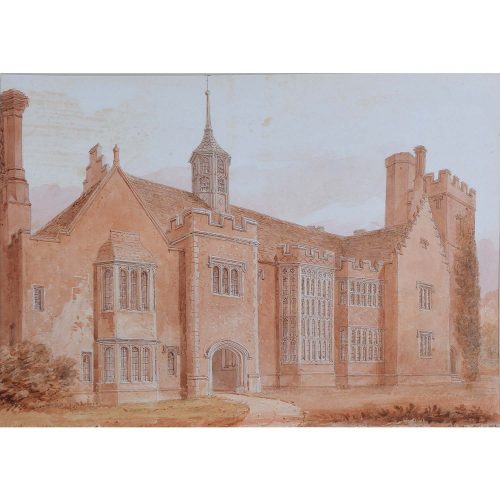
John Chessell Buckler (1793-1894)
Horham Hall Essex 1830
Watercolour 25 x 35.5 cm 44 x 57 cm including frame, UK shipping only J C Buckler was an esteemed architect, coming second to Charles Barry in the competition for the design of the new Houses of Parliament in 1836. However, his greatest passion was recording the details of historical buildings. 'With such subjects before me as cathedrals, abbeys and ancient parish churches...I never made any effort to increase the number of my employments as an architect.' Buckler 1852 Harmoniously working with his father and younger brother, Buckler drew and preserved the designs of ancient structures, many of which no longer survive today. Horham Hall is stands as a fortunate exception. If you are interested email info@manningfineart.co.uk or call us on 07929 749056. Condition: Good. -
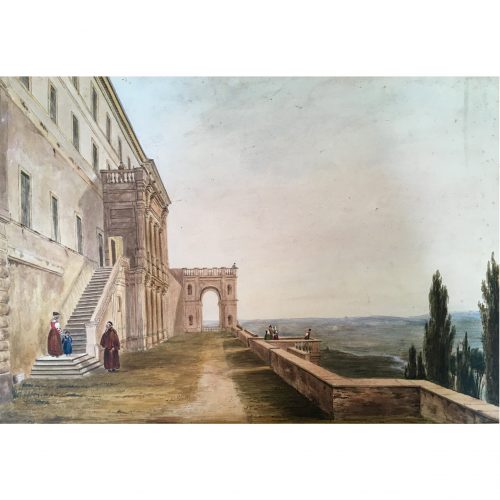
Anonymous
'View from an Italian Villa'
19th century Watercolour 31.5 x 44cm If you are interested email info@manningfineart.co.uk or call us on 07929 749056. Condition: Good. A few foxing spots to top right. -

John Speed/Speede (1551/2-1629) The Countye Palatine of Chester with that most ancient citie
39x51cm Engraving Probably the most famous early English mapmaker, John Speed's early life is somewhat of an enigma. He is believed to have trained as a rolling-press printer, but he was at heart an historian granted a sinecure in the Customs House by Queen Elizabeth to indulge his passion, later becoming a Fellow of the Society of Antiquaries. His first maps were historical, of the Holy Land 'Canaan as it was Possessed both in Abraham and Israels Dayes' and of England and Ireland recording 'all their Civill Warres since the Conquest'. In 1611 he published his 'Hostory of Great Britaine' which he regarded as his magnum opus, but it was the companion atlas 'Theatre of the Empire of Great Britaine' that - as the first printed atlas of Great Britain - sealed his reputation. William Rogers engraved the first map, 'the County Palatine of Chester' in about 1600, but following his untimely death the task of engraving was passed to Jodocus Hondius of Amsterdam. By 1612 the atlas was complete, the maps famed for their decorative elements. Many have town plans - Brtiain's first series of such plans - and descriptive text was printed to the reverse until the 1676 edition. Later printings (up until 1770) were issued without this text. By 1627 it has become a part of a world atlas 'Prospect of the Most Famous Parts of the World'. During the 17th century the plates passed through the hands of a series of publishers, the 1676 edition (as here) of Thomas Bassett and Richard Chiswell being regarded as its high point with the inclusion for the first time of a series of important maps. If you are interested email info@manningfineart.co.uk or call us on 07929 749056. Condition: Trimmed and other small losses outside platemark. Some toning and spotting to paper as usual. Later but well undertaken hand-colouring. Old tape mark to top outside platemark. Generally good condition. -
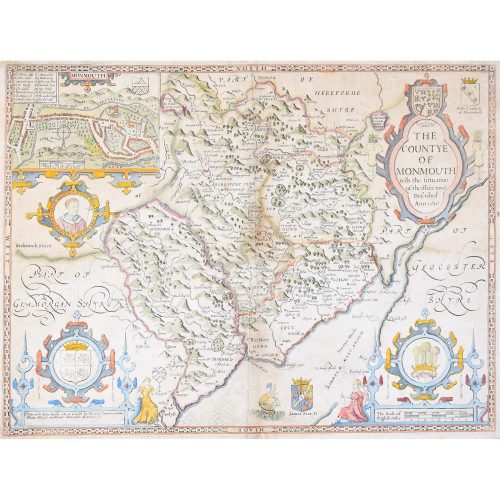
John Speed/Speede (1551/2-1629) The Countye of Monmouthshire
Performed by John Speede assisted by William Smyth. And are to be sold by Henry Overton at the White Horse without Newgate London. Printed 1710-1743 Probably the most famous early English mapmaker, John Speed's early life is somewhat of an enigma. He is believed to have trained as a rolling-press printer, but he was at heart an historian granted a sinecure in the Customs House by Queen Elizabeth to indulge his passion, later becoming a Fellow of the Society of Antiquaries. His first maps were historical, of the Holy Land 'Canaan as it was Possessed both in Abraham and Israels Dayes' and of England and Ireland recording 'all their Civill Warres since the Conquest'. In 1611 he published his 'Hostory of Great Britaine' which he regarded as his magnum opus, but it was the companion atlas 'Theatre of the Empire of Great Britaine' that - as the first printed atlas of Great Britain - sealed his reputation. William Rogers engraved the first map, 'the County Palatine of Chester' in about 1600, but following his untimely death the task of engraving was passed to Jodocus Hondius of Amsterdam. By 1612 the atlas was complete, the maps famed for their decorative elements. Many have town plans - Britain's first series of such plans - and descriptive text was printed to the reverse until the 1676 edition. Later printings (up until 1770) were issued without this text. By 1627 it has become a part of a world atlas 'Prospect of the Most Famous Parts of the World'. During the 17th century the plates passed through the hands of a series of publishers, the 1676 edition of Thomas Bassett and Richard Chiswell being regarded as its high point with the inclusion for the first time of a series of important maps. For the first half of the eighteenth century they were firmly established in the hands of the Overton family. If you are interested email info@manningfineart.co.uk or call us on 07929 749056. Condition: Small losses outside platemark just reaching platemark at top, with some toning to paper as usual. Later but well undertaken hand-colouring. Generally good condition. -
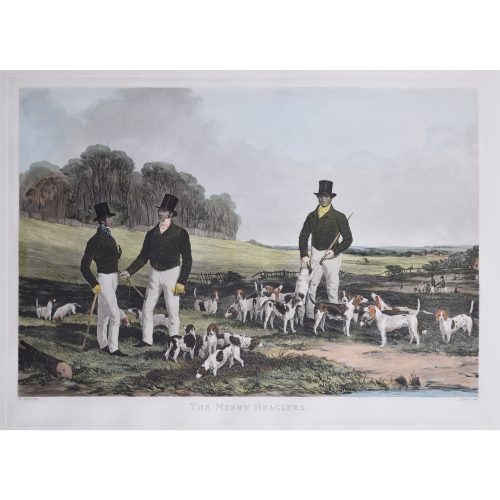
John Harris after Harry Hall The Merry Beaglers
Restrike print - c. mid twentieth century 48x65cm Aquatint with hand colouring The most famous beagling print there is, after the 1845 painting. If you are interested email info@manningfineart.co.uk or call us on 07929 749056. -
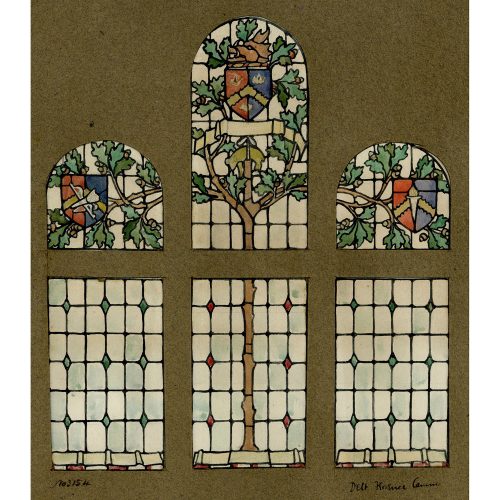
Florence Camm (1874-1960)
Heraldic Stained Glass Window Design with Oak Leaves
Watercolour 20x18cm Click for biographical details and other works by Camm. If you are interested email info@manningfineart.co.uk or call us on 07929 749056. -
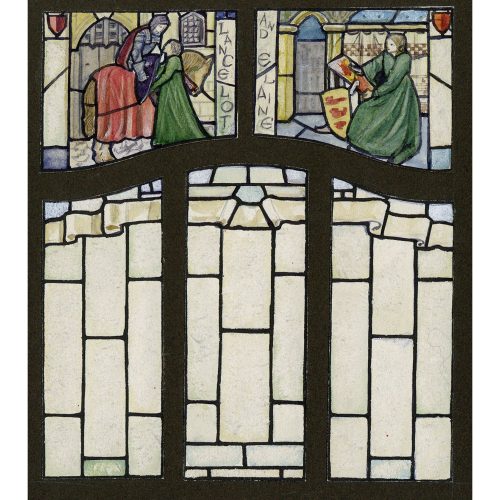
Florence Camm (1874-1960)
Lancelot and Elaine Stained Glass Window Design
Watercolour 13.5x11.5cm Design for TW Camm & Co., Smethwick, Birmingham. If you are interested email info@manningfineart.co.uk or call us on 07929 749056. -
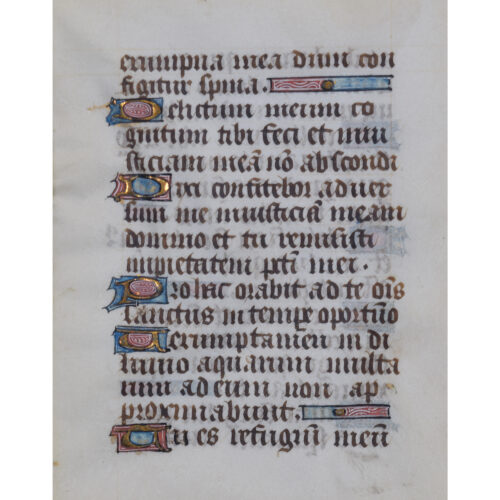
Illuminated psalter - Psalm 31
Illuminated manuscript on vellum 15 x 11 (sheet), 11 x 9 cm (framed area) A beautifully illuminated psalter page, including the Latin text of Psalm 31. Condition: generally very good; some creases to vellum; age toning to margins (not affecting the illuminated area). Will be framed two-sided with age-toned margins not visible. If you are interested, please email info@manningfineart.co.uk or call us on 07929 749056. -
Sale!
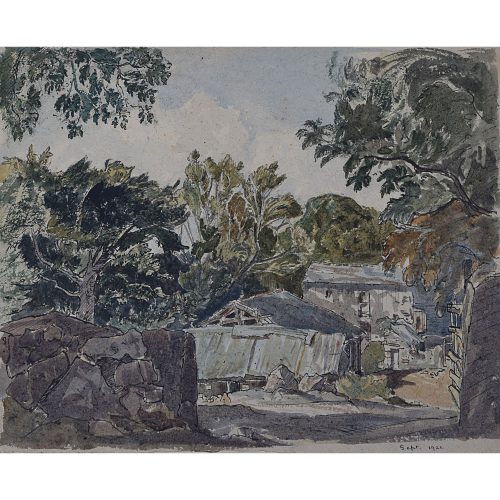
Claude Muncaster (1903-1974) Farmstead and Trees
Dated Sept 1921 Signed on reverse with additional sketches of figures Watercolour 22x28cm Claude Grahame Muncaster, RWS, ROI, RBA, SMA was the son of Oliver Hall RA. At the age of fifteen his career as a landscape painter began, and he soon took to the seas, spending the 1920s and 30s travelling the world with his sketchbook in a series of vessels. With the outbreak of war and he joined the RNVR training as a navigator. Having left school at fifteen his mathematics was very weak and it was a relief for all when his artistic talents meant he was recruited as a camofleur. A master of capturing seascapes he was therefore able to hide huge ships ‘in plain sight’ with clever disguises. After the war he painted for the Royal Family and was a frequent guest at Sandringham. Claude Muncaster was a watercolourist known for his landscapes and maritime scenes. He was born Grahame Hall, the son of the Royal Academician Oliver Hall who taught his son to paint from an early age; Grahame first exhibited his work aged 15 and a few years later was showing at the RA. However, he adopted the name Claude Muncaster in 1922 to dissociate his career from that of his father. Muncaster’s primary choice of subject matter came from a genuine love of the sea. He made several long-distance sea voyages, including one around the Horn as a deckhand in the windjammer Olivebank in 1931, which he described in ‘Rolling Round the Horn’, published in 1933. Armed with a sketchbook, his aim was to be able to ‘paint ships and the sea with greater authority’. This he certainly achieved, perfectly capturing the limpid first light of morning over the Port of Aden, the choppy rain-grey waters of the Bay of Biscay and a streak of sunlight through gathering storm clouds at dusk in Exeter. He became an Associate of the Royal Watercolour Society in 1931 and was a founder member, and later President, of the Royal Society of Marine Artists. During the Second World War, Muncaster served in the Royal Naval Volunteer Reserve (RNVR) from 1940-44, training as a navigator before going on to advise on the camouflage of ships, and also worked as an official war artist. In ‘Still Morning at Aden’ (1944) he depicts Allied warships in this safe anchorage in the Middle East; the back is stamped with Admiralty approval. In 1946-7 he was commissioned by the Queen to produce watercolours of the royal residences at Windsor, Sandringham and Balmoral; the Duke of Edinburgh, in a foreword to a biography of Muncaster, recalls looking at these and considering the artist’s ‘unerring instinct for a subject’, his sense of atmosphere. Other commissions included large panoramas of the Thames and of Bradford. His career also included work as an etcher, illustrator, writer, lecturer and broadcaster, and his paintings can be found in the Royal Academy, Tate, National Maritime Museum Cornwall, National Railway Museum and Royal Air Force Museum. Condition: generally good, few isolated spots to sky as can be seen in the magnified version of the picture. If you are interested email info@manningfineart.co.uk or call us on 07929 749056. -
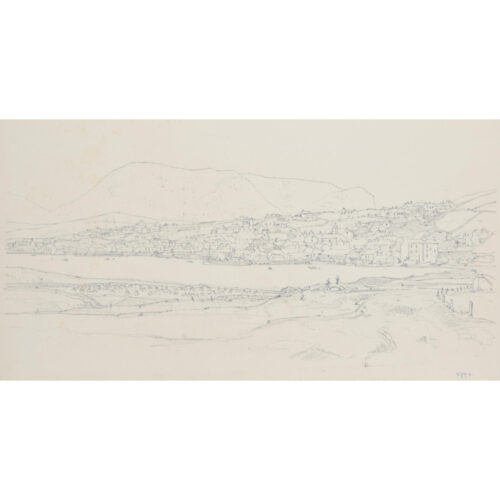
Claude Muncaster (1903 - 1974)
Stromness, Orkney
Pencil drawing 23 x 53 cm A drawing of Stromness, Orkney, with two figures in the foreground. The buildings seem tiny in comparison to the huge cliffs overlooking the town. Claude Grahame Muncaster, RWS ROI RBA SMA was the son of Oliver Hall RA. He was born Grahame Hall (his father was the Royal Academician Oliver Hall, who taught his son to paint from an early age) but adopted the name Claude Muncaster in 1922, hoping to strike out on his own and dissociate his career from that of his father. His career as a landscape painter began when he was fifteen; he spent the 1920s and 30s travelling the world with his sketchbook by boat. Muncaster’s primary choice of subject matter came from a genuine love of the sea. He made several long-distance sea voyages, including one around the Horn as a deckhand in the windjammer Olivebank in 1931, which he described in ‘Rolling Round the Horn’, published in 1933. Armed with a sketchbook, his aim was to be able to ‘paint ships and the sea with greater authority’. This he certainly achieved, perfectly capturing the limpid first light of morning over the Port of Aden, the choppy rain-grey waters of the Bay of Biscay and a streak of sunlight through gathering storm clouds at dusk in Exeter. He became an Associate of the Royal Watercolour Society in 1931 and was a founder member, and later President, of the Royal Society of Marine Artists. When the Second World War broke out, Muncaster joined the Royal Naval Reserves, training as a navigator before going on to advise on the camouflage of ships. He also worked as an official war artist. In ‘Still Morning at Aden’ (1944) he depicts Allied warships in this safe anchorage in the Middle East; the back is stamped with Admiralty approval. In 1946-7 he was commissioned by the Queen to produce watercolours of the royal residences (some of which are available below); the Duke of Edinburgh, in a foreword to a biography of Muncaster, recalls looking at these and considering the artist’s ‘unerring instinct for a subject’, his sense of atmosphere. Other commissions included large panoramas of the Thames and of Bradford. His career also included work as an etcher, illustrator, writer, lecturer and broadcaster, and his paintings can be found in the Royal Academy, Tate, National Maritime Museum Cornwall, National Railway Museum and Royal Air Force Museum. He was a frequent guest at Sandringham for the rest of his life. If you are interested, please email info@manningfineart.co.uk or call us on 07929 749056. Click here for other works by the artist. -
 Frank Algernon Stewart (1877-1945) The Heythrop at Stow on the Wold Lithograph 24 x 63cm Signed in pencil. Framed. A typical hunting print by Stewart, showing one of the country's leading packs. Condition: Slight, even, loss of colour, as expected. If you’d like to know more, please email info@manningfineart.co.uk or call us on 07929 749056.
Frank Algernon Stewart (1877-1945) The Heythrop at Stow on the Wold Lithograph 24 x 63cm Signed in pencil. Framed. A typical hunting print by Stewart, showing one of the country's leading packs. Condition: Slight, even, loss of colour, as expected. If you’d like to know more, please email info@manningfineart.co.uk or call us on 07929 749056. -
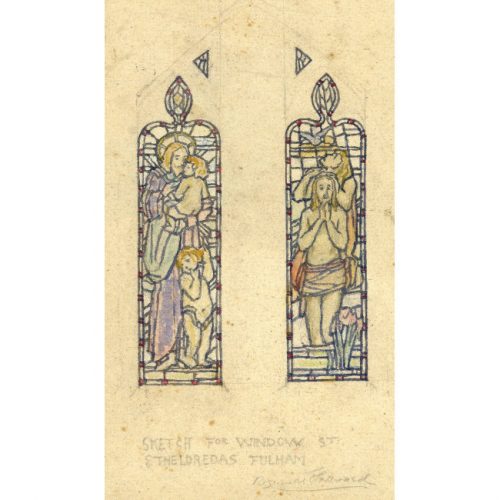
Reginald Hallward (1858-1948)
Sketch for window at St Etheldreda’s, Fulham
Pencil and gouache 12×7cm Click here for biographical details and other works by the artist. If you are interested email info@manningfineart.co.uk or call us on 07929 749056. -
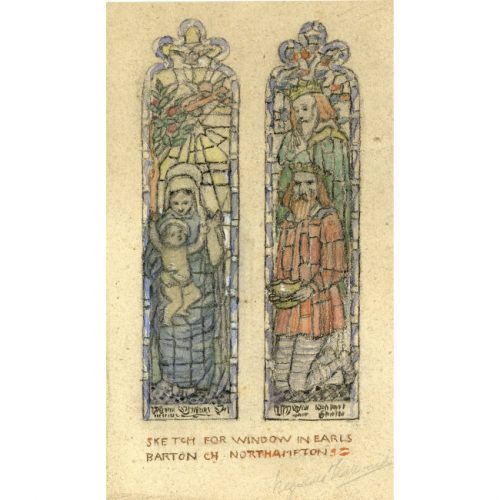
Reginald Hallward (1858-1948)
Sketch for window in Earls Barton Church Northampton
Pencil and gouache 12×9.5cm Click here for biographical details and other works by the artist. If you are interested email info@manningfineart.co.uk or call us on 07929 749056. -
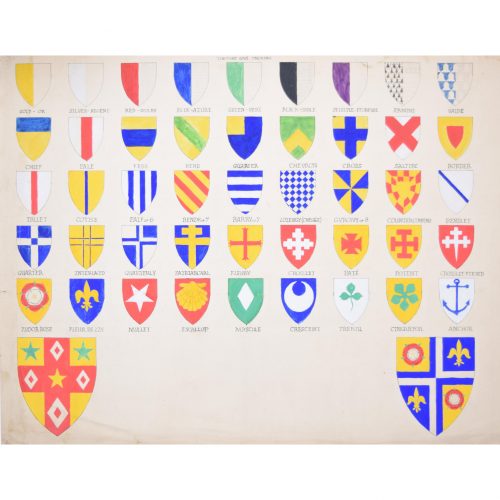
S Clapham (active 1940 - 1960)
A Heraldic Primer
Gouache and pencil 53 x 67 cm A delightful, brightly-coloured study of the various elements of heraldic shields. Condition: good; a few short and neatly-repaired marginal tears. If you are interested, please email info@manningfineart.co.uk or call us on 07929 749056. Click here for other works by the artist. -
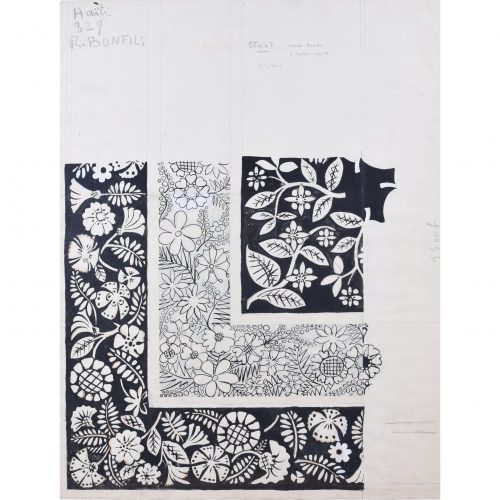
Robert Bonfils (French: 1886-1972) Design for scarf for Bianchini Ferrier
'Haiti' 66x50cm Gouache and pencil Provenance: Christies, 25-27 July 2001 Bianchini Textiles sale Born in Paris, Bonfils spent between 1903-1909 at various Parisian art schools: the École Germain Pilon, the École Nationale Supérieure des Arts Décoratifs (where he subsequently taught for thirty-two years), and the École des Beaux Arts. From 1909 he exhibited regularly at the Salon d'Automne, by 1912 he was exhibiting at Salon des Artistes Décorateurs and then subsequently at Tuileries and abroad. He was an organiser of the 1925 Paris International Exposition of Modern Industrial and Decorative Arts, and the 1937 Exposition. His relationship with Bianchini commenced in 1915 who produced many of his textile designs. He was made Chevalier de la Légion d'honneur in 1926, being promoted to Officier in 1938. If you are interested email info@manningfineart.co.uk or call us on 07929 749056. Condition; Good. -
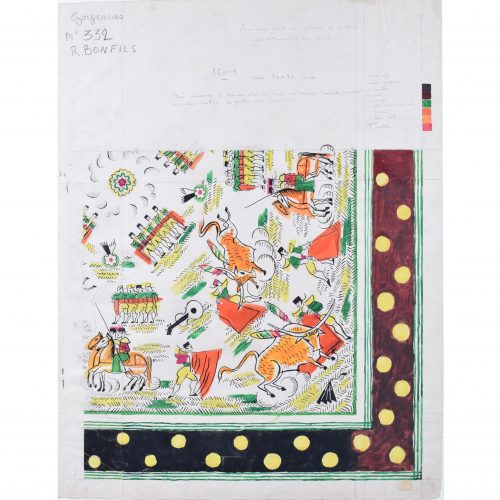
Robert Bonfils (French: 1886-1972) Design for scarf for Bianchini Ferrier
No.332 Goyescas 65x50cm Gouache and pencil Provenance: Christies, 25-27 July 2001 Bianchini Textiles sale Born in Paris, Bonfils spent between 1903-1909 at various Parisian art schools: the École Germain Pilon, the École Nationale Supérieure des Arts Décoratifs (where he subsequently taught for thirty-two years), and the École des Beaux Arts. From 1909 he exhibited regularly at the Salon d'Automne, by 1912 he was exhibiting at Salon des Artistes Décorateurs and then subsequently at Tuileries and abroad. He was an organiser of the 1925 Paris International Exposition of Modern Industrial and Decorative Arts, and the 1937 Exposition. His relationship with Bianchini commenced in 1915 who produced many of his textile designs. He was made Chevalier de la Légion d'honneur in 1926, being promoted to Officier in 1938. If you are interested email info@manningfineart.co.uk or call us on 07929 749056. Condition; Good. -
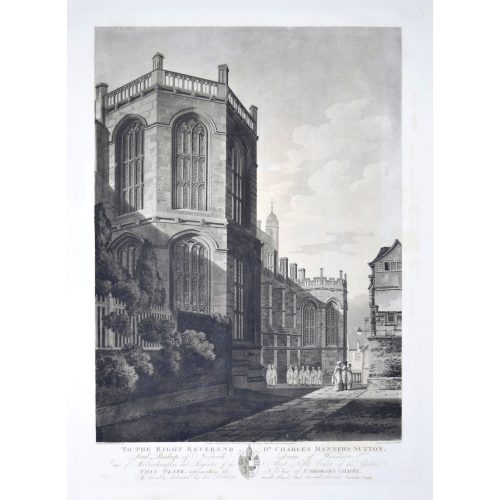
Frederick Nash (1782-1856) Drawn and etched Engraved by F C Lewis North East View of St George's Chapel, Windsor
To the Right Reverend the Lord Bishop of Norwich and Dean of Windsor London Published by F Nash, No 6 Asylum Buildings, Westminster Road July 12 1804 55x40cm Frederick Nash was born in Lambeth. Initially studying architectural drawing under Thomas Malton he subsequently enrolled at the Royal Academy of Arts. From 1801 to 1809 he worked with the antiquarians John Britton and Edward Wedlake Brayley, subsequently becoming a member of the Society of Painters in Watercolours - a group of painters who had left the Royal Academy following complaints of under-recognition of their works. Latterly primarily a landscape painter he toured the rivers of Germany. Prints from this series are in the British Museum and also in the collection of Anglesea Abbey, a National Trust property outside Cambridge, England, with a very large collection of views of Windsor Castle. If you are interested email info@manningfineart.co.uk or call us on 07929 749056. Condition: A good impression In generally very good condition. Not trimmed. -
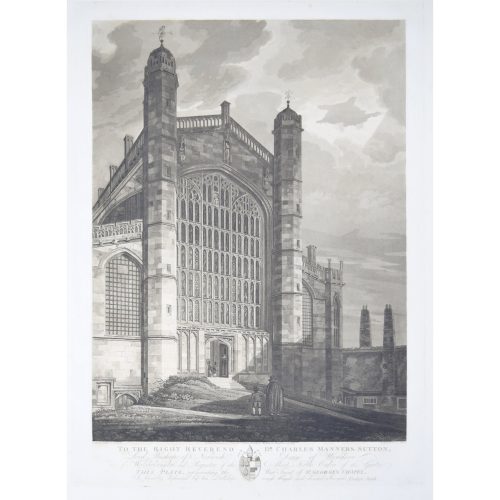
Frederick Nash (1782-1856) Drawn and etched Engraved by F C Lewis West Front of St George's Chapel, Windsor
To the Right Reverend the Lord Bishop of Norwich and Dean of Windsor London Published by F Nash, No 6 Asylum Buildings, Westminster Road July 12 1804 55x40cm Frederick Nash was born in Lambeth. Initially studying architectural drawing under Thomas Malton he subsequently enrolled at the Royal Academy of Arts. From 1801 to 1809 he worked with the antiquarians John Britton and Edward Wedlake Brayley, subsequently becoming a member of the Society of Painters in Watercolours - a group of painters who had left the Royal Academy following complaints of under-recognition of their works. Latterly primarily a landscape painter he toured the rivers of Germany. Prints from this series are in the British Museum and also in the collection of Anglesea Abbey, a National Trust property outside Cambridge, England, with a very large collection of views of Windsor Castle. If you are interested email info@manningfineart.co.uk or call us on 07929 749056. Condition: A good impression In generally very good condition. Not trimmed. -
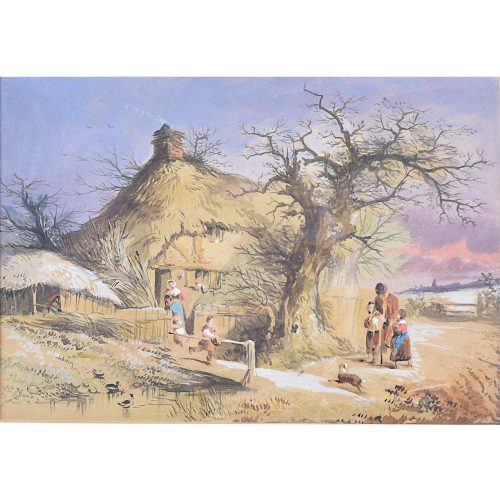
Attributed to Joseph Murray Ince (1806-1859) Outside Welsh Border Cottage - Winter
Watercolour 10.5x17.5cm Brought up in Radnorshire, in the Welsh Borders, Ince studied under David Cox from 1823-1826, and then exhibited at the Royal Academy. He was a drawing master at Cambridge University during the 1830s, during which period he painted many views of the Colleges of both Oxford and Cambridge, returning to Radnorshire in 1835. His works are in the collections of major galleries including the Tate, The V&A and The Fitzwilliam Museum in Cambridge. Click to view other works by Ince. -

Joseph Murray Ince (1806-1859) Outside Welsh Border Cottage - Summer
Watercolour 10.5x17.5cm Provenance (label to reverse) Fine Art Society 1971 Signed lower right 'J M Ince 1827' Brought up in Radnorshire, in the Welsh Borders, Ince studied under David Cox from 1823-1826, and then exhibited at the Royal Academy. He was a drawing master at Cambridge University during the 1830s, during which period he painted many views of the Colleges of both Oxford and Cambridge, returning to Radnorshire in 1835. His works are in the collections of major galleries including the Tate, The V&A and The Fitzwilliam Museum in Cambridge. -

Frederick Nash (1782-1856) Drawn and etched
Engraved by F C LewisSouth East View of St George's Chapel, Windsor
To the Right Reverend the Lord Bishop of Exeter London Published by F Nash, No 6 Asylum Buildings, Westminster Road July 12 1804 39.5x52cm Frederick Nash was born in Lambeth. Initially studying architectural drawing under Thomas Malton he subsequently enrolled at the Royal Academy of Arts. From 1801 to 1809 he worked with the antiquarians John Britton and Edward Wedlake Brayley, subsequently becoming a member of the Society of Painters in Watercolours - a group of painters who had left the Royal Academy following complaints of under-recognition of their works. Latterly primarily a landscape painter he toured the rivers of Germany. -
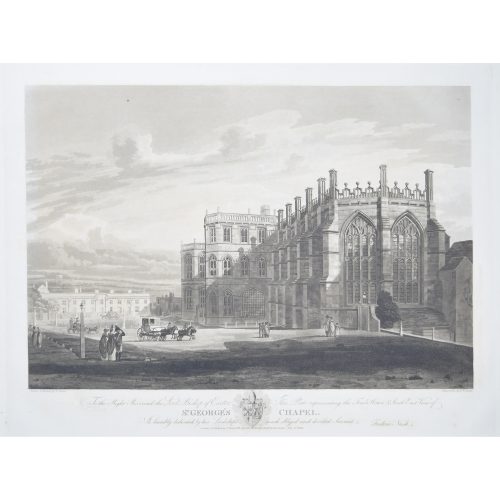
Frederick Nash (1782-1856) Drawn and etched
Engraved by F C LewisSouth East View of St George's Chapel, Windsor
To the Right Reverend the Lord Bishop of Exeter London Published by F Nash, No 6 Asylum Buildings, Westminster Road July 12 1804 39.5x52cm Frederick Nash was born in Lambeth. Initially studying architectural drawing under Thomas Malton he subsequently enrolled at the Royal Academy of Arts. From 1801 to 1809 he worked with the antiquarians John Britton and Edward Wedlake Brayley, subsequently becoming a member of the Society of Painters in Watercolours - a group of painters who had left the Royal Academy following complaints of under-recognition of their works. Latterly primarily a landscape painter he toured the rivers of Germany. -
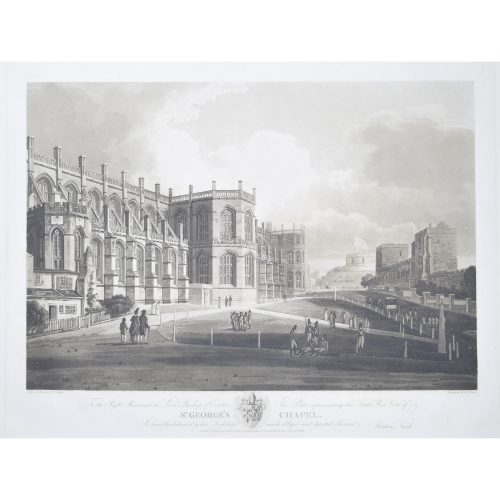
Frederick Nash (1782-1856) Drawn and etched
Engraved by F C LewisSouth West View of St George's Chapel, Windsor
To the Right Reverend the Lord Bishop of Exeter London Published by F Nash, No 6 Asylum Buildings, Westminster Road July 12 1804 39.5x52cm Frederick Nash was born in Lambeth. Initially studying architectural drawing under Thomas Malton he subsequently enrolled at the Royal Academy of Arts. From 1801 to 1809 he worked with the antiquarians John Britton and Edward Wedlake Brayley, subsequently becoming a member of the Society of Painters in Watercolours - a group of painters who had left the Royal Academy following complaints of under-recognition of their works. Latterly primarily a landscape painter he toured the rivers of Germany. -
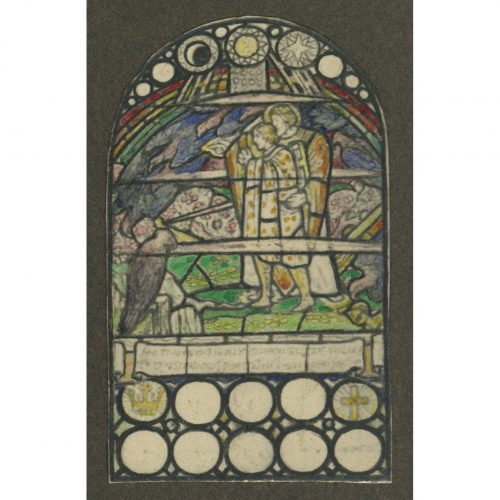
Florence Camm (1874-1960)
Valley of the Shadow of Death Stained Glass Window Design for Wrekin College (1936)
Watercolour 9x6cm Design for TW Camm & Co., Smethwick, Birmingham. If you are interested email info@manningfineart.co.uk or call us on 07929 749056. -
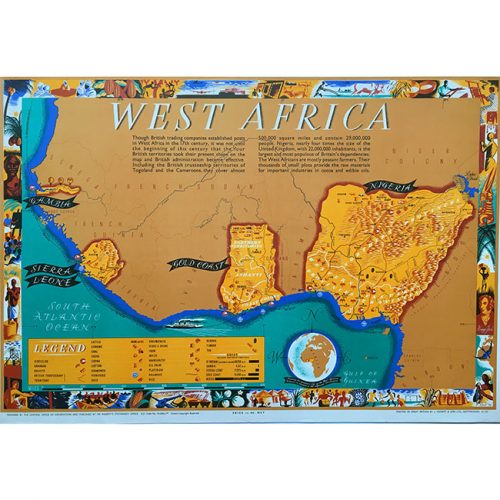
Leo Vernon
West Africa (British Empire 1948)
Printed by J.Howitt & Son Ltd Lithographic poster 20×30 inches If you are interested email info@manningfineart.co.ukor call us on 07929 749056 -

Reginald Hallward Grapevine Altar Cloth Design
Reginald Hallward Grapevine Altar Cloth Design Watercolour and pencil Click here for biographical details and other works by the artist. If you are interested email info@manningfineart.co.uk or call us on 07929 749056. -
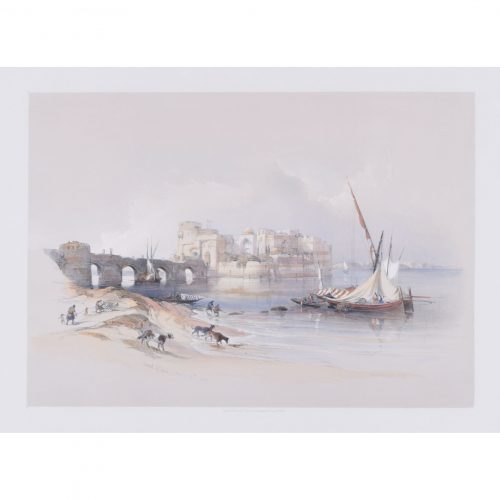
David Roberts (1769 - 1864)
Citadel of Sidon - April 28th, 1839 (published 1943)
Lithograph with hand-colouring 23 x 35 cm (sheet size 17.5 x 24.5 cm) The Citadel of Sidon, or Sidon Sea Castle, was built by crusaders in the thirteenth century as a fortress of the holy land. This lithograph is part of David Roberts' series of views of the Holy Land, which he produced from sketches made during lengthy tours of the Near East in the 1830s. Egypt was much in vogue at this time, and travellers, collectors and lovers of antiquities were keen to buy works inspired by the East or depicting the great monuments of ancient Egypt; Roberts was more than happy to produce pictures on this lucrative theme. Queen Victoria was one of his 400 subscribers, and her set of lithographs is still held by the Royal Collection Trust. The lithographer Louis Haghe worked with Roberts to turn the original sketches into high-quality lithographs, which were then published in the 1840s by the printer F. G. Moon in London. David Roberts RA RBA was a Scottish painter known for his Orientalist pictures. He was elected as a Royal Academician in 1841. -
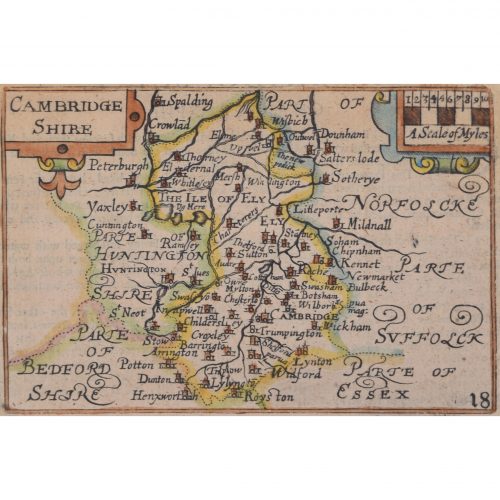
Pieter van den Keere (1571 - circa 1646) after John Speed (1551 or 1552 - 1629)
Map of Cambridgeshire (1627)
Engraving 8 x 12 cm A beautifully coloured map of Cambridgeshire, with an antique description of the county to the reverse. The map, along with many others, was published in Speed's atlas, 'The Theatre of the Empire of Great Britaine', first published in 1611. This particular miniature edition of the 'Theatre' was published in miniature by George Humble in 1627, entitled 'England Wales Scotland and Ireland Described and Abridged With ye Historic Relation of things worthy memory from a farr larger Voulume. Done by John Speed.’ Speed's original map was likely engraved for this edition by Peter van den Keere. van den Keere's maps soon came to be known as "Miniature Speeds". John Speed was an English cartographer, chronologer and historian. The son of a citizen and Merchant Taylor in London, he rose from his family occupation to accept the task of drawing together and revising the histories, topographies and maps of the Kingdoms of Great Britain as an exposition of the union of their monarchies in the person of King James I and VI. He accomplished this with remarkable success, with the support and assistance of the leading antiquarian scholars of his generation. He drew upon and improved the shire maps of Christopher Saxton, John Norden and others, being the first to incorporate the hundred-boundaries into them, and he was the surveyor and originator of many of the town or city plans inset within them. His work helped to define early modern concepts of British national identity. His Biblical genealogies were also formally associated with the first edition of the King James Bible. He is among the most famous of English mapmakers. George Humble (1572 - 1640) was an English publisher, known for his publication of John Speed's 'The theatre of the empire of Great Britaine,' the first comprehensive atlas depicting the British Isles, and his later 'A prospect of the most famous parts of the World,' the first English world atlas. Pieter van den Keere was a Flemish engraver, publisher, and globe maker who worked in England and the Dutch Republic. Condition: generally very good; some age toning. If you’d like to know more, please email info@manningfineart.co.uk or call us on 07929 749056. -
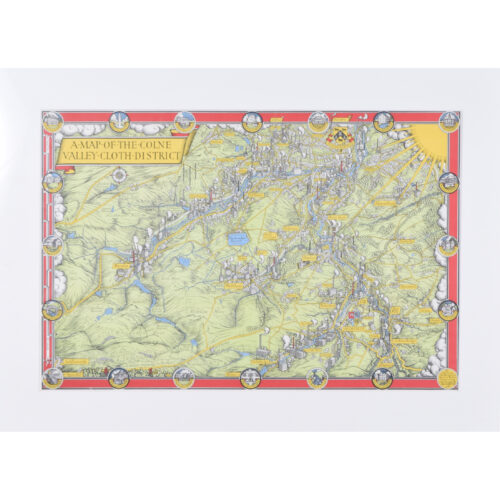
Leslie Macdonald "Max" Gill (1884 - 1947)
A Map of the Colne Valley Cloth District (1946)
Engraving with later hand-colouring 32 x 48 cm Signed in the plate and dated 1946. Produced for Huddersfield and District Woollen Export Group. Gill's vibrant and detailed map depicts the Colne Valley District. The Colne Valley was a loom-weaving area which played a significant role in the development of the Industrial Revolution when water-powered textile mills were brought in. Born in Brighton, Max Gill was the second son in a family of thirteen children; his elder brother was Eric Gill, the typographer and sculptor. Both Gills exhibited significant talent at a young age. Max Gill’s first map was made for a school map-drawing project following which he entered maps into competitions in boys’ magazines. In 1903 he moved to London as assistant to the ecclesiastical architects Sir Charles Nicholson and Hubert Corlette. By 1908 he had started his own architectural practice, but in 1909 Sir Edwin Lutyens commissioned Gill to paint a “wind dial” map for Nashdom, a large house in Buckinghamshire. The wind dial was set over the fireplace and attached to a weather vane on the roof, allowing the occupant to know the direction of the wind from the comfort of the house. He produced seven further wind dials including for Lutyens’s Lindisfarne Castle and for the Allhusen Room at Trinity College, Cambridge. Although Gill continued to practice as an architect, Frank Pick commissioned him to create seven pictorial maps for the Underground, the first being the famous 1913 ‘Wonderground Map of London Town.’ In 1917 he joined the Imperial War Graves Commission’s headstone design committee, designing the typeface and regimental badges. Gill’s memorials for the fallen in the First World War include for Balliol and Worcester Colleges and Christ Church in Oxford. During the 1920s and 30s Gill undertook many commercial commissions for advertising materials. The Empire Marketing Board and Shell-Mex as well as further maps for the Underground. He designed in 1922 the first diagrammatic map of the Underground which provided the foundation for Beck’s more famous map. By the 1930s his major works were murals. Those of the Arctic and Antarctic on the ceilings of the Scott Polar Research Institute in Cambridge are beautiful, but the most impressive is the map of the North Atlantic in the first-class dining room of the Queen Mary (maiden voyage: 1936, now moored at Long Beach, California). During the Second World War he created a series of propaganda posters for the Ministry of Information. Condition: very good. In new hand-finished frame. If you are interested, please email info@manningfineart.co.uk or call us on 07929 749056. Click here for other decorative maps. -
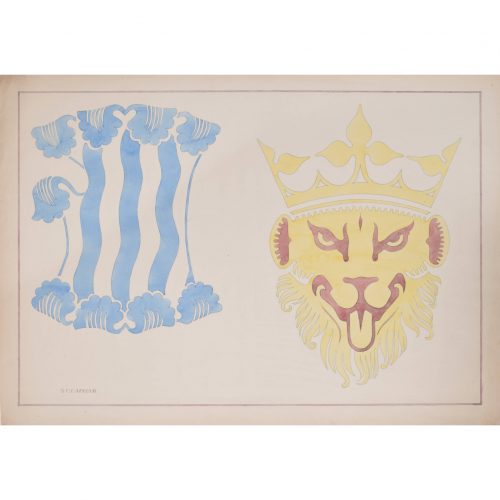
S Clapham (active 1940 - 1960)
A Pair of Heraldic Designs
Watercolour 49 x 70 cm Signed lower right. Clapham was an architect based in Stockwell in London. Condition: generally very good; short repaired edge tear (barely visible) to left side. If you are interested, please email info@manningfineart.co.uk or call us on 07929 749056. Click here for other works by the artist. -
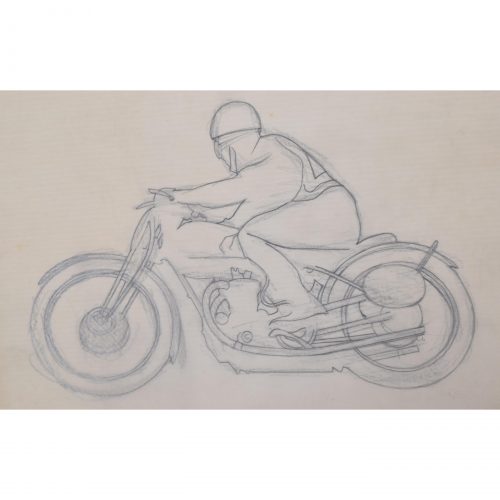
Gerald Mac Spink (flourished 1920 - 1940)
Motorcyclist
Pencil on tracing paper 20 x 32 cm Spink was a skilled artist, illustrator, and designer who produced a series of posters in the inter-war period for companies including the London Underground, Southern Railways, LNER, Hawker Engineering, and British Steel. He won a prize in 1933 from the Imperial Institute for his poster artwork. He also worked as an aeronautical engineer in Kingston-on-Thames for Hawker Engineering; his greatest achievement was the creation of the 'Squanderbug', a 500cc racing car which he built in 1947, and which races even to this day. Provenance: the artist's estate. Condition: generally very good. If you are interested, please email info@manningfineart.co.uk or call us on 07929 749056. Click here for other works by the artist. -
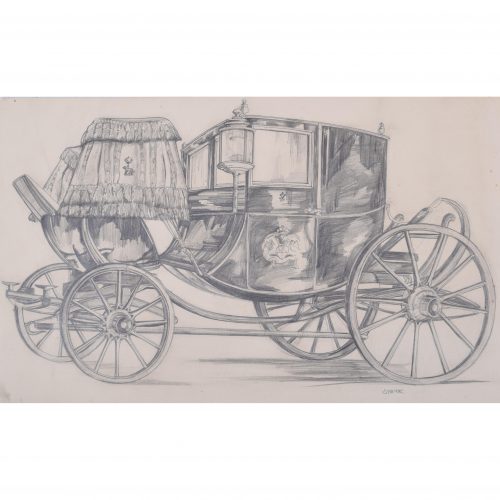
Gerald Mac Spink (flourished 1920 - 1940)
Stagecoach
Pencil 32 x 53 cm Signed 'Spink' lower right. Spink was a skilled artist, illustrator, and designer who produced a series of posters in the inter-war period for companies including the London Underground, Southern Railways, LNER, Hawker Engineering, and British Steel. He won a prize in 1933 from the Imperial Institute for his poster artwork. He also worked as an aeronautical engineer in Kingston-on-Thames for Hawker Engineering; his greatest achievement was the creation of the 'Squanderbug', a 500cc racing car which he built in 1947, and which races even to this day. Provenance: the artist's estate. Condition: generally very good. If you are interested, please email info@manningfineart.co.uk or call us on 07929 749056. Click here for other works by the artist. -
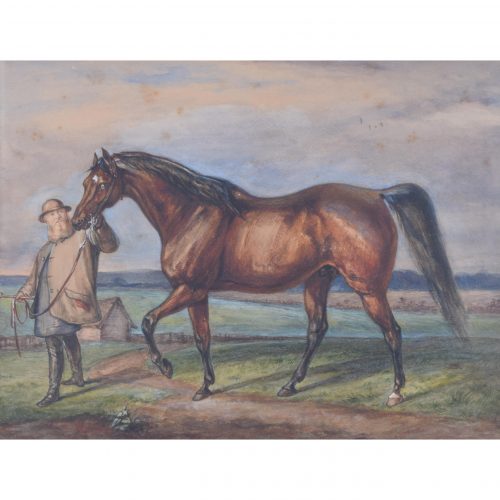
H. Fluiss
Cotherstone with stud groom "Wilson" (1862)
Watercolour 30 x 39 cm A late-nineteenth century watercolour depicting Cotherstone, the British Thoroughbred racehorse and sire. In a career that lasted from September 1841 to July 1843, he ran eleven times and won eight races. Provenance: Christie's South Kensington (2002). Condition: generally very good; couple of faint spots to sky. Frame in "country house" condition. If you are interested, please email info@manningfineart.co.uk or call us on 07929 749056. -
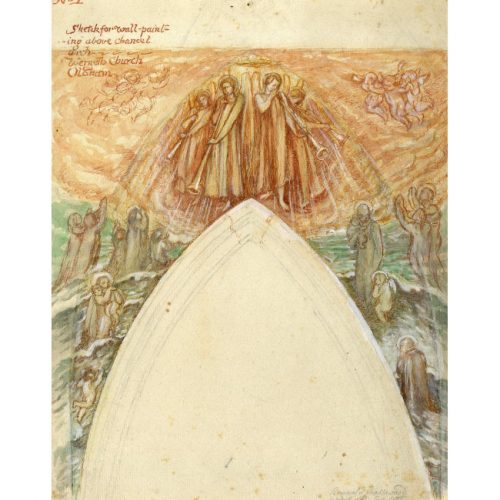
Reginald Hallward (1858-1948)
Design for wall painting at Werneth Church, Oldham
Watercolour with highlights 22 x 16 cm Click here for biographical details and other works by the artist. If you are interested email info@manningfineart.co.uk or call us on 07929 749056. -
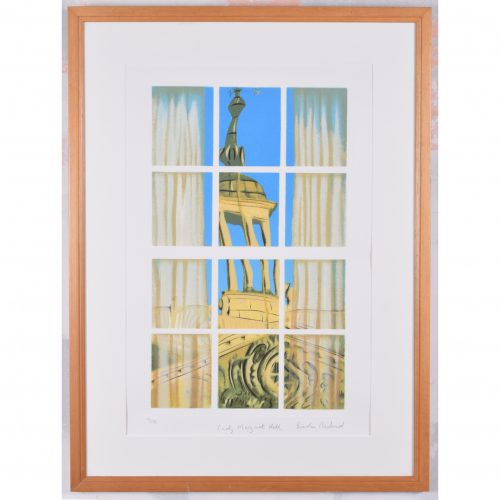
Brendan Neiland (b. 1941) R.A. (Expelled)
Lady Margaret Hall
Screenprint 46 x 27 cm Signed, titled, and numbered 42/175 in pencil. A screenprint of the cupola atop Lady Margaret Hall's Talbot Building. Reflected architecture is one of Neiland’s most recurring themes. Neiland's work is widely exhibited in major museums and galleries worldwide including, in Britain, the Victoria and Albert Museum, The Tate Gallery London, The Collections of the British Council, and the Arts Council of Great Britain. He is represented by the Redfern Gallery and has had numerous shows internationally, including at the Galerie Belvedere in Singapore, who represent him in Singapore and the Far East. Condition: very good. If you are interested, please email info@manningfineart.co.uk or call us on 07929 749056. Click here for other views of Lady Margaret Hall. -
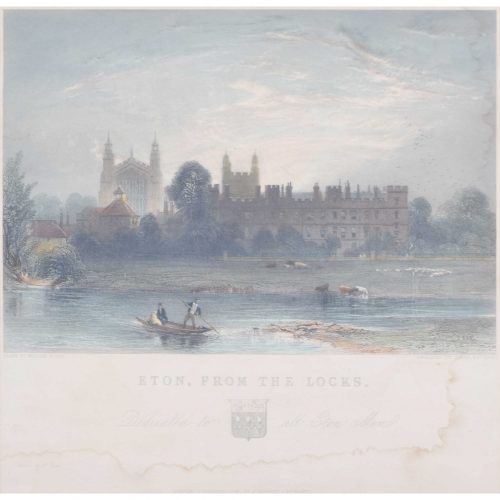
James Redaway (1797 - 1858)
Eton from the Locks
Hand-coloured engraving 27 x 28 cm Redaway's view of Eton College, seen from the locks on the River Thames. James Redaway was a nineteenth-century engraver, principally of landscapes and architectural subjects. Condition: some staining to lower half of print. If you’d like to know more, please email info@manningfineart.co.uk or call us on 07929 749056. -
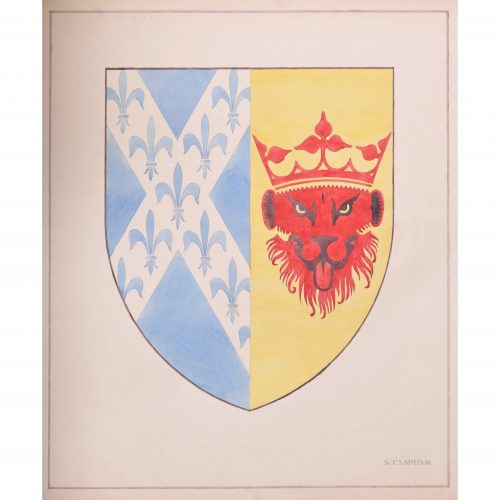
S Clapham (active 1940 - 1960)
Heraldic Design
Watercolour 51 x43 cm Signed lower right. Clapham was an architect based in Stockwell in London. Condition: very good. If you are interested, please email info@manningfineart.co.uk or call us on 07929 749056. Click here for other works by the artist. -
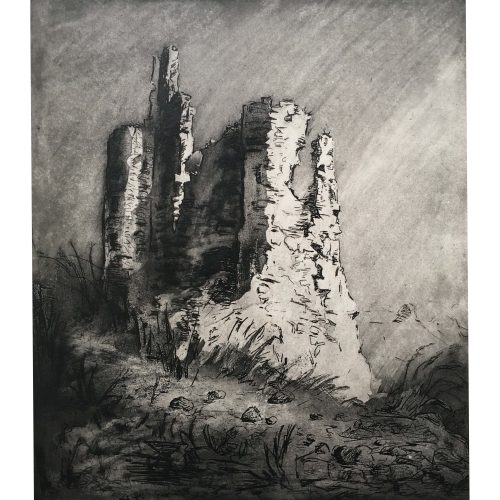
Louise Ibels (1891-1965) Castle Ruins
Etching and aquatint Signed and numbered 13/30 in pencil to margin Approx. 44x39cm (plate) A French artist known for her charming etchings, here she captures the romance of the ruined castle with the strong contrast between light and shade, a shaft of sunlight bearing down from the right. If you are interested email info@manningfineart.co.uk or call us on 07929 749056. Condition: Excellent. -
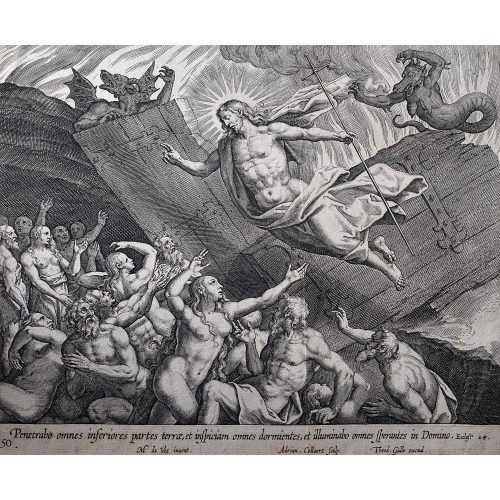
Theodoor Galle (c. 1571-1633) Jan Collaert (1545-1628) after Maerten de Vos (1532 - 1603) 50. Penetrabo omnes inferiores partes terre, et inspiciam omnes dormientes, et illuminabo omnes sperantes in Domino. Eccles. 24.
Engraving From Vita, Passio, et Resurrectio Iesu Christi first published 1598, this a later edition published by Joannes Galle (1600-1676) 17.5x22cm
From the Gospel of Ecclesiasticus, Chapter 24 "Penetrate all the lower parts of the earth, and behold all and illuminate all who hope in the Lord." Theodoor Galle was the son of Philip Galle, a Dutch publisher best known for his old master prints, from whom he learnt the craft. Theodoor married a daughter of the prominent family of Plantin in Antwerp. His marriage established the productive partnership between the Galle workshop and the Plantin Moretus printing house. A talented workman, Galle quickly became a respected engraver, print publisher and a member of the guild of St Luke, a city guild for artists in 1595. In the years to follow he became the guild's deacon. Adriaen Collaert was born in Antwerp between 1555 and 1565, becoming wijnmeester of the Guild of St Luke in 1580 - a title reserved for the sons of guild members. The guild of St Luke was generally the city guild for artists. Working for Philip Galle, a Dutch publisher best known for his old master prints, he married Galle's daughter Justa. After learning the principles of engraving in the Netherlands, he spent some years in Italy improving his skill. Upon returning to Flanders he engraved, in accomplished fashion, a great number of plates. His brother, Jan Collaert II, his son, Jan Baptist Collaert II and a grandson were all printmakers. These particular plates are after paintings by Maerten de Vos, a Flemish painter and draughtsman. His father was Pieter de Vos, from whom he learned. From 1550 - 1558 he travelled in Italy, visiting Rome and Venice and becoming master of the Antwerp Guild of St Luke upon his return in 1558. After 1575 he was mainly engaged in producing print designs. If you are interested email info@manningfineart.co.uk or call us on 07929 749056. Condition: Trimmed to plate margins, generally good condition commensurate with age, slight age toning and handling marks as evident from image. -
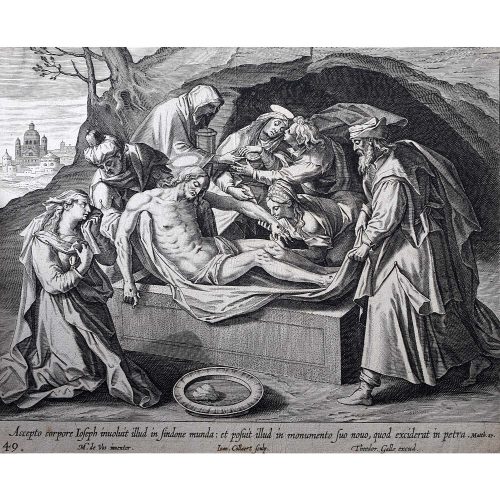
Theodoor Galle (c. 1571-1633) Jan Collaert (1545-1628) after Maerten de Vos (1532 - 1603) 49. Accepto corpore Ioseph inuoluit in sindone munda: et posuit illud in monumento suo nouo, quod exciderat in petra. Matth. 27.
Engraving From Vita, Passio, et Resurrectio Iesu Christi first published 1598, this a later edition published by Joannes Galle (1600-1676) 17.5x22cm From the Gospel of Matthew, Chapter 27 "Taking the body, wrapped in a linen cloth and placed it in his own new tomb, which had been cut into the rock." Theodoor Galle was the son of Philip Galle, a Dutch publisher best known for his old master prints, from whom he learnt the craft. Theodoor married a daughter of the prominent family of Plantin in Antwerp. His marriage established the productive partnership between the Galle workshop and the Plantin Moretus printing house. A talented workman, Galle quickly became a respected engraver, print publisher and a member of the guild of St Luke, a city guild for artists in 1595. In the years to follow he became the guild's deacon. These particular plates are after paintings by Maerten de Vos, a Flemish painter and draughtsman. His father was Pieter de Vos, from whom he learned. From 1550 - 1558 he travelled in Italy, visiting Rome and Venice and becoming master of the Antwerp Guild of St Luke upon his return in 1558. After 1575 he was mainly engaged in producing print designs. If you are interested email info@manningfineart.co.uk or call us on 07929 749056. Condition: Trimmed to plate margins, generally good condition commensurate with age, slight age toning and handling marks as evident from image.

